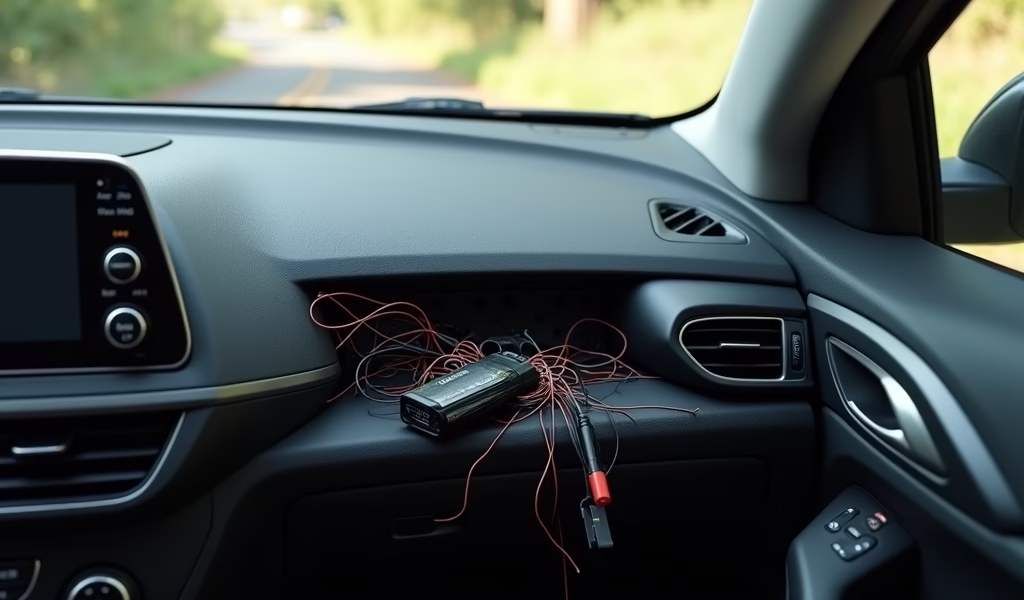Overview
This article provides expert advice on maximizing radar detector performance through proper installation, covering optimal mounting locations, power options, cable management, interference avoidance, settings configuration, testing, and maintenance. For best results, mount the detector high on the windshield behind the rearview mirror, consider hardwiring for a clean installation, manage cables professionally, maintain distance from interference sources, customize settings for your driving environment, test thoroughly after installation, and perform regular maintenance.
Table of Contents
- Introduction
- Choosing the Optimal Mounting Location
- Power Connection Options
- Proper Cable Management
- Avoiding Interference Sources
- Programming and Settings Configuration
- Testing Your Installation
- Maintenance and Care Tips
- Conclusion
- Frequently Asked Questions
Introduction
Installing a radar detector might seem as simple as sticking it on your windshield and plugging it in, but there’s a lot more to it if you want maximum performance. As a mechanic who’s installed hundreds of these devices over my 15-year career, I’ve seen firsthand how proper installation can be the difference between getting ample warning about speed traps and getting a ticket.
The right radar detector installation can dramatically increase detection range, reduce false alerts, and provide a cleaner, more professional look in your vehicle. Many drivers spend hundreds on a premium detector but then compromise its performance with poor placement or improper setup.
Whether you’re installing your first detector or looking to improve your current setup, these seven installation tips will help you get the most out of your investment. Let’s make sure that expensive piece of technology does exactly what it’s supposed to do – give you advance warning when it matters most.
Choosing the Optimal Mounting Location

The mounting location of your radar detector is absolutely critical to its performance. Think of it as finding the perfect spot for a security camera – position is everything.
The ideal location is high on your windshield, centered behind your rearview mirror. This gives your detector the clearest “view” of the road ahead without creating a blind spot for you. Mounting it high allows the detector to see over your hood and other vehicles, maximizing its detection range.
Avoid mounting your detector too low on the dashboard or windshield. Many drivers make this mistake thinking it’s less visible to others, but it severely limits performance. The lower the detector, the more your vehicle’s hood blocks incoming signals.
Equally important is avoiding obstructions. Keep your detector away from:
- Windshield wipers’ resting position
- Areas with metallic windshield tint
- Heated windshield zones (often visible as tiny wires in the glass)
- Heads-up display (HUD) projection areas
For vehicles with advanced driver assistance systems, be careful not to block any sensors or cameras typically mounted near the rearview mirror. If space is tight, position your detector slightly off-center rather than mounting it too low.
Remember that most quality detectors offer 360-degree protection, so they need clear “sight lines” in all directions. Even rear detection can be compromised by improper mounting, so keep the back window of your detector unobstructed as well.
Power Connection Options
When it comes to powering your radar detector, you’ve got three main options, each with its own set of pros and cons.
The standard cigarette lighter adapter is the most common method – it’s simple, requires no modification to your vehicle, and allows easy transfer between cars. The downside? That dangling wire doesn’t just look messy – it screams “expensive electronics inside” to anyone passing by your parked vehicle.
Hardwiring your detector directly to your vehicle’s fuse box is my preferred method for daily drivers. This gives you a clean, wire-free appearance and automatically powers your detector on and off with your vehicle. The initial setup takes about 30-45 minutes, but the professional look and convenience are well worth it.
If you’re reasonably comfortable with basic automotive electrical systems, hardwiring is a straightforward DIY project:
- Purchase a hardwire kit specific to your detector model
- Locate an appropriate fused circuit that powers on/off with the ignition
- Connect the positive and ground wires according to the kit instructions
- Route the wire neatly behind trim panels to your detector mount
For those not comfortable with DIY electrical work, most car audio shops can handle this installation for a reasonable fee (typically $30-75).
A third option gaining popularity is direct-to-battery power with a built-in voltage monitor. These kits power your detector even when the vehicle is off, but automatically disconnect to prevent battery drain. This setup is ideal for drivers who want constant protection in high-risk parking situations.
Whichever power method you choose, ensure all connections are secure. Loose power connections are among the most common causes of intermittent detector performance.
Proper Cable Management
Nothing ruins a clean radar detector installation faster than a wire dangling across your dashboard. Beyond looking unprofessional, loose cables can create distractions, snag on things, and even become a safety hazard.
Start by routing your power cable along the headliner (the fabric covering your roof interior). The edge where your headliner meets the windshield usually has a natural gap perfect for tucking a wire. From there, follow the A-pillar (the front-most roof support) down toward your power source.
Most A-pillar trim can be gently pulled away from the pillar without removing it completely, creating just enough space to hide a wire behind it. Take your time and use a plastic trim tool rather than a screwdriver to avoid damaging the trim.
For a truly professional look, consider these cable management tools:
- Adhesive cable clips (attach to clean surfaces on your dash or A-pillar)
- Split wire loom (covers and protects exposed sections of wire)
- Zip ties (use sparingly and only where they won’t be visible)
- Double-sided mounting tape (for securing excess wire)
If you’re using the cigarette lighter for power, pay special attention to how the wire drapes from your windshield to your power outlet. This section often creates the most noticeable wire “droop.” Try routing it along the edge of your dash and securing it with small adhesive clips.
Remember that temperature extremes can affect adhesives. If you live in an area with very hot summers or cold winters, check your cable management occasionally and reapply adhesive clips if necessary.
Avoiding Interference Sources
Modern vehicles are packed with electronics that can interfere with your radar detector, causing annoying false alerts that eventually lead to “alert fatigue” – where you start ignoring warnings altogether.
The most common interference culprits include:
- Blind-spot monitoring systems
- Adaptive cruise control
- Collision avoidance systems
- Lane departure warnings
- Some aftermarket LED lighting
- Poorly shielded USB chargers and power inverters
To minimize interference, maintain at least 3-4 inches of separation between your radar detector and other electronic devices. This includes smartphones, GPS units, and dashcams. If you’re using multiple windshield-mounted devices, position them as far apart as possible.
Many newer radar detectors include built-in filtering technology to reduce false alerts from vehicle systems. These filters are constantly being improved through firmware updates, so keep your detector’s software current.
If you’re experiencing persistent false alerts, systematically eliminate potential causes. Try temporarily disconnecting or relocating other electronic devices to identify the source. Sometimes something as simple as swapping out a cheap USB charger can make a dramatic difference in detector performance.
Some vehicle-based interference is unavoidable, particularly in newer cars loaded with driver assistance features. In these cases, familiarize yourself with the pattern of these false alerts so you can distinguish them from actual threats.

Programming and Settings Configuration
Even the most perfectly positioned radar detector won’t perform well without proper settings configuration. Most drivers simply power up their new detector and leave it on factory default settings – a huge mistake that leads to unnecessary false alerts and missed detections.
Start with the basic city/highway modes. Highway mode maximizes sensitivity for open-road driving, while city mode reduces sensitivity to minimize false alerts from automatic doors, speed signs, and other urban radar-like signals. Some advanced detectors offer auto-switching between these modes based on your speed.
If your detector offers band-specific adjustments, consider customizing these based on your location. For example, X-band radar is rarely used for speed enforcement in most areas but generates many false alerts from automatic doors. Consider reducing X-band sensitivity while maintaining full K and Ka band detection.
GPS-equipped detectors offer powerful additional features worth configuring:
- Mark and remember locations that consistently trigger false alerts
- Create alerts for red light and speed cameras
- Set speed-based sensitivity (more sensitive above certain speeds)
- Automatically mute alerts when traveling below a set speed
Take time to explore your specific model’s advanced settings. Many premium detectors offer specialized modes like “AutoLearn” that automatically identify and remember false alert locations, or “Advanced K-band filtering” that can dramatically reduce false alerts from vehicle radar systems.
Don’t be intimidated by your detector’s manual – most manufacturers now offer online setup guides and video tutorials that make configuration much easier than it was in years past.
Testing Your Installation
After installation and initial setup, thorough testing is essential to ensure your radar detector is working properly. Don’t wait for an actual speed trap to discover installation problems.
Start with a basic functionality check: power on your detector and verify it completes its startup sequence correctly. If your model has GPS functionality, confirm it acquires a satellite lock within a reasonable time (usually under a minute from cold start).
For real-world testing, find “known radar” locations in your area. Common test locations include:
- Shopping centers with automatic doors (usually K-band)
- Areas with speed display signs (often K-band)
- Stretches of highway known for regular enforcement
- Areas with stationary photo radar or speed cameras
Pay attention to detection range during testing. You should receive alerts well before visually spotting the source. If detection seems delayed or weaker than expected, reconsider your mounting position and check for obstructions.
For more thorough testing, consider buddying up with another radar detector user. Following each other on the same route with different detectors can quickly reveal if your unit is underperforming. If your friend’s detector consistently alerts earlier than yours on the same signals, something may be wrong with your installation.
Don’t forget to test for false alerts as well. If your daily commute produces constant false alerts, you’ll need to refine your settings or investigate interference sources.
Maintenance and Care Tips
A properly installed radar detector isn’t a “set it and forget it” device. Regular maintenance ensures consistent performance over the years.
Keep your detector clean, particularly the front and rear sensor windows. Dust, bug splatter, and road grime can accumulate and reduce sensitivity. Use a soft microfiber cloth slightly dampened with water or glass cleaner to gently clean these surfaces. Avoid harsh chemicals that might damage the detector’s plastic housing.
Check your power connections periodically, especially if you’re using the cigarette lighter adapter. These connections can loosen over time due to vehicle vibration. If your detector seems to randomly lose power or reset while driving, a loose connection is the most likely culprit.
For suction cup mounts, clean both the cup and the windshield regularly to maintain a strong seal. In extreme temperatures, suction cups can lose their grip, so check your mount stability when seasons change. Many experienced users keep a spare mount in their glove compartment just in case.
Perhaps most importantly, keep your detector’s firmware updated. Manufacturers regularly release updates that improve performance, add features, and enhance filtering capabilities. Most modern detectors can be updated via computer connection or even smartphone apps.
During seasonal changes, you might need to adjust your detector’s settings and positioning. Winter sun angles are different from summer ones, potentially creating new glare issues. Extreme temperature swings can also affect adhesive mounts and power connections.
Conclusion
Proper radar detector installation isn’t just about aesthetics – it’s about maximizing the performance of a device you’re counting on to help you drive safely and avoid tickets. The difference between a hastily mounted detector and one that’s thoughtfully installed can be hundreds of feet of additional warning time.
Take the time to find the optimal mounting position high on your windshield, consider hardwiring for a cleaner installation, manage your cables professionally, minimize interference, configure settings properly, test thoroughly, and maintain your detector regularly. These seven steps will ensure your radar detector performs at its absolute best.
Remember that radar detection technology is constantly evolving in response to new enforcement methods. Even the best installation can’t overcome outdated equipment, so consider updating your detector every few years if you rely heavily on its protection.
With these installation tips, you’ll get the maximum performance from your radar detector investment – and hopefully avoid those expensive speeding tickets for years to come. Drive safely!
Frequently Asked Questions
Is it legal to install a radar detector in my vehicle?
Radar detectors are legal in passenger vehicles in most U.S. states except Virginia and Washington D.C. However, they are generally illegal in commercial vehicles and on military bases.
How high should I mount my radar detector on my windshield?
Mount your detector as high as possible on your windshield while still allowing for easy access to controls. The ideal position is usually centered behind your rearview mirror.
Will my radar detector work through a heated windshield?
Heated windshields significantly reduce radar detection range because their embedded wires block signals. If possible, find a “window” in the heated area or consider a remote-mount detector option.
How often should I update my radar detector’s firmware?
Check for firmware updates at least quarterly, or whenever the manufacturer announces a new release. Regular updates improve filtering capabilities and often add new features at no cost.
Can I transfer my hardwired radar detector to another vehicle?
Yes, but it requires disconnecting the wiring in your current vehicle and installing a new hardwire kit in the second vehicle. Consider quick-disconnect hardwire kits if you frequently switch between vehicles.


Pingback: Radar Detector Accessories: Top 7 Picks - knowsyourcar.com